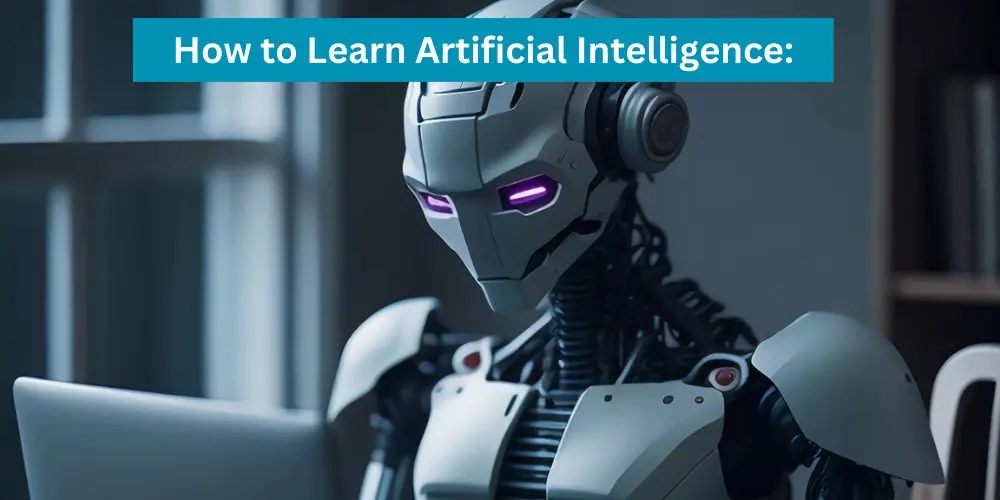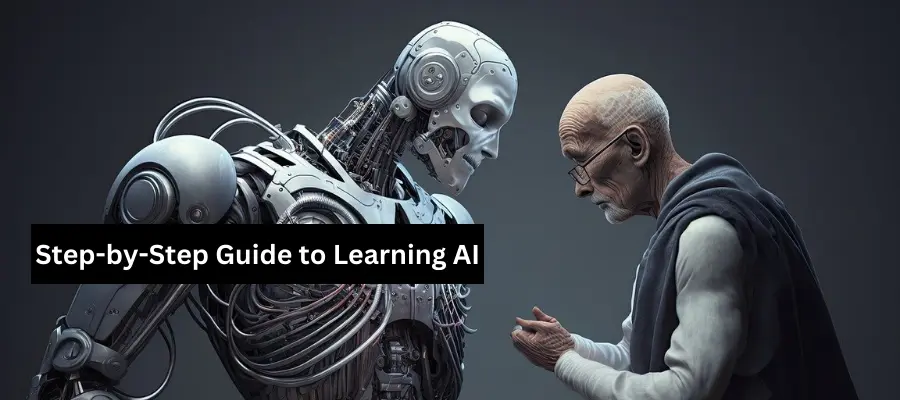How to Learn Artificial Intelligence: A Beginner’s Roadmap
Published: 01 Jan 2025
Artificial Intelligence (AI) is transforming the way we live, work, and interact with technology. From voice assistants like Siri to self-driving cars and personalized Netflix recommendations, AI is all around us, making tasks easier and more efficient.
But if you’re new to the field, you might wonder: How can I learn AI, and is it even possible for a beginner to get started? The good news is that yes, anyone with the right mindset and resources can begin their AI journey. Whether you’re looking to pursue a career in AI or simply curious about how machines can “think,” this guide will provide you with a clear roadmap to get started.

What is Artificial Intelligence?
Before you start learning AI, it’s essential to understand what it actually is.
Artificial Intelligence refers to the simulation of human intelligence in machines. These machines are designed to perform tasks such as reasoning, learning, problem-solving, perception, and even understanding language. The goal is to make machines smart enough to mimic human abilities, allowing them to perform tasks that would traditionally require human intelligence. what is artificial intelligence
AI is everywhere today. Whether you’re using Google Search, navigating through your smartphone, or shopping online, AI is behind many of these actions. It can be broadly divided into two categories:
Narrow AI:
- Specialized in performing a single task, such as playing chess or recommending products online.
General AI:
- Theoretical AI that would have the ability to perform any intellectual task that humans can do (this is still a future goal).
- Learning AI not only opens doors to exciting career opportunities but also helps you better understand the technology that powers the world around us. what is machine vision
What Do You Need to Learn AI?
AI may sound intimidating, but breaking it down into smaller, digestible pieces will make the process much easier. Here are the basic skills and concepts you’ll need to get started:
Mathematics
AI heavily relies on mathematical concepts. Don’t worry, though—this doesn’t mean you need to be a math expert. The most important areas to focus on are:
Algebra: Understanding variables and equations is foundational.
Statistics: AI models rely on data, and statistics helps you make sense of it. Concepts like probability, averages, and standard deviations are key. what machine learn can do
Calculus & Linear Algebra: These are more advanced topics but are crucial for understanding AI algorithms, particularly machine learning and deep learning.
Programming
The ability to code is essential for building AI models and working with AI tools. Python is the most commonly used programming language for AI because it’s easy to learn and has a wide array of libraries and frameworks (such as TensorFlow, PyTorch, and Scikit-learn) that simplify AI development.
If you’re brand new to programming, don’t worry! There are many free resources and tutorials to help you learn Python from scratch.
Data Understanding
AI thrives on data. You’ll need to understand how to manipulate and process data, so learning the basics of data structures (arrays, lists, etc.) and databases is important. Learning how to clean and visualize data will also play a significant role in your AI work.
Curiosity & Problem-Solving Mindset
AI is a complex and evolving field, so a strong curiosity and willingness to learn is vital. Being comfortable with trial and error, and keeping an open mind, will help you overcome the challenges of learning this field. advantages of artificial intelligence
Step-by-Step Guide to Learning AI

Before jumping into courses and tutorials, take a moment to plan your learning journey. This helps you stay organized and focused as you progress.
Assess your current knowledge:
Do you have a background in math or programming? Are you familiar with any AI concepts? Knowing where you stand helps you start at the right level. uses of artificial intelligence
Familiarize yourself with basic AI terminology.
Focus on linear algebra, calculus, probability, and statistics.
Study optimization methods (e.g., gradient descent).
Master Python programming, as it’s essential for AI development.
Get familiar with Python libraries like NumPy, Pandas, Matplotlib, and Scikit-learn.
Understand data structures and algorithms (arrays, trees, graphs).
Learn common AI algorithms (search, sorting, and graph traversal).
Study supervised, unsupervised, and reinforcement learning.
Learn about key algorithms: Linear Regression, Decision Trees, SVM, and Random Forests.
Study neural networks and deep learning concepts (activation functions, backpropagation).
Explore AI frameworks like TensorFlow, Keras, and PyTorch.
Understand Natural Language Processing (NLP) basics like tokenization and stemming.
Learn computer vision techniques using Convolutional Neural Networks (CNNs).
Study reinforcement learning (Q-learning, Policy Gradient Methods, DQN).
Work on real-world projects and build AI models on datasets (e.g., Kaggle challenges).
Machine Learning (ML):
ML is a subset of AI that focuses on teaching machines to learn from data. Start by learning about supervised learning (where the machine learns from labeled data) and unsupervised learning (where the machine identifies patterns in unlabeled data). Tools like Scikit-learn make it easy to implement machine learning algorithms.
Deep Learning:
Deep learning is a more advanced subset of machine learning. It uses artificial neural networks to model complex patterns in data. Neural networks are behind technologies like image recognition, natural language processing, and even self-driving cars.
Natural Language Processing (NLP):
NLP allows machines to understand and generate human language. It’s the foundation of chatbots, language translation tools, and voice assistants like Siri. You can start learning NLP using Python libraries such as NLTK or spaCy.
The key to learning these concepts is to apply them by building small projects. For example, try building a simple recommendation system, image classifier, or chatbot to reinforce your learning.
Step 4: Get Hands-On Experience with Tools and Libraries
As you learn, it’s important to get hands-on experience with the tools that power AI. Here are some popular libraries and frameworks to familiarize yourself with:
- TensorFlow: One of the most popular libraries for building deep learning models.
- Keras: A user-friendly API for building neural networks with TensorFlow.
- Scikit-learn: A versatile library for implementing various machine learning algorithms.
- PyTorch: Another powerful library for deep learning that’s gaining popularity.
- These tools will allow you to implement the algorithms and techniques you’ve learned and help you build real-world applications. artificial intelligence complete info
Step 5: Specialize and Keep Learning
As you gain proficiency, you might want to specialize in one area of AI. Some potential focus areas include:
- Computer Vision: Building models to understand images and videos (used in facial recognition, autonomous vehicles, etc.).
- Reinforcement Learning: Teaching machines to make decisions by interacting with their environment (used in gaming, robotics, etc.).
- AI Ethics: Understanding the societal implications of AI, such as fairness, bias, and privacy.
- AI is a fast-moving field, so continuous learning is key. Stay updated on the latest trends, research, and breakthroughs by following AI blogs, attending webinars, and participating in online communities.
Conclusion:
Learning AI is an exciting and rewarding journey, but it does require dedication and effort. By following the roadmap outlined in this article, you’ll be on your way to mastering the basics and beyond.
AI and Machine Learning Quiz on Coursera
Platform: Coursera
Link: Coursera AI Quiz
Description: This quiz is part of the “Machine Learning” course by Andrew Ng and is widely regarded as one of the best for beginners. It covers basic AI and machine learning concepts, and helps assess your understanding of key topics like supervised and unsupervised learning, linear regression, and more. Perfect for anyone starting out in AI!
Answer: There are many great resources to learn AI. For beginners, online courses like Andrew Ng’s Machine Learning on Coursera and Deep Learning Specialization are highly recommended. Other resources include books like “Hands-On Machine Learning with Scikit-Learn, Keras, and TensorFlow” by Aurélien Géron, and websites like Kaggle for real-world datasets and competitions.
How long does it take to learn AI?
Answer: The time it takes to learn AI varies depending on your background. If you’re starting from scratch, expect to spend anywhere from 6 months to 2 years mastering the basics of AI, machine learning, and deep learning. A typical learning path includes 3–6 months of learning foundational concepts and math (e.g., linear algebra, calculus, probability), followed by 6–12 months of learning machine learning algorithms, deep learning, and working on projects.
Proudly powered by WordPress






